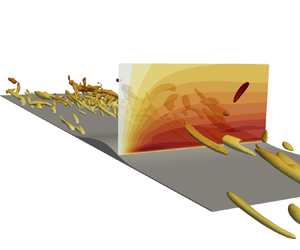No CrossRef data available.
Article contents
Curvature effects on the structure of near-wall turbulence
Published online by Cambridge University Press: 06 October 2023
Abstract

The interaction between near-wall turbulence and wall curvature is described for the incompressible flow in a plane channel with a small concave–convex–concave bump on the bottom wall, with height comparable to the wall-normal location of the main turbulent structures. The analysis starts from a database generated by a direct numerical simulation and hinges upon the anisotropic generalised Kolmogorov equations, i.e. the exact budget equations for the second-order structure function tensor. The influence of the bump on the wall cycle and on the energy production, redistribution and transfers is described in the physical and scale spaces. Over the upstream side of the bump, the energy drained from the mean flow to sustain the streamwise fluctuations decreases, and the streaks of high and low streamwise velocity weaken and are stretched spanwise. After the bump tip, instead, the production of streamwise fluctuations grows and the streaks intensify, progressively recovering their characteristic spanwise scale. The wall-normal fluctuations, and thus the quasi-streamwise vortices, are sustained by the mean flow over the upstream side of the bump, while energy flows from the vertical fluctuations to the mean field over the downstream side. On the concave portion of the upstream side, the near-wall fluctuations form structures of spanwise velocity which are consistent with Taylor–Görtler vortices at an early stage of development. Their evolution is described by analysing the scale-space pressure–strain term. A schematic description of the bump flow is presented, in which various regions are identified according to the signs of curvature and streamwise pressure gradient.
JFM classification
- Type
- JFM Papers
- Information
- Copyright
- © The Author(s), 2023. Published by Cambridge University Press





